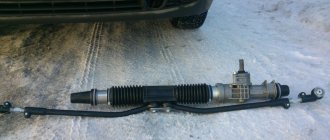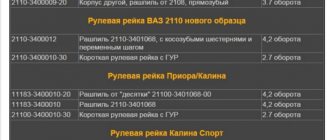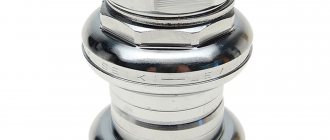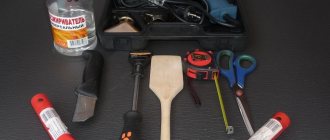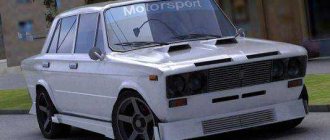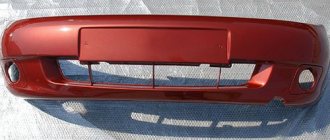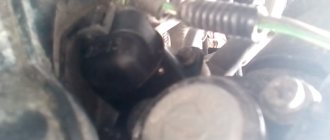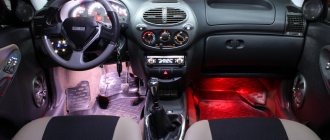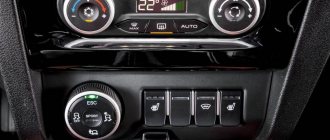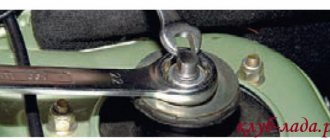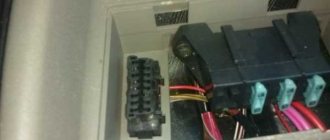The development of the Lada Kalina design began at AvtoVAZ in the 90s. A line of cars was conceived, including the 1119 sedan, 1118 hatchback and minivan. The last model was never implemented; instead, a station wagon 1117 was developed. In 1999, a hatchback prototype was demonstrated, and in 2000, a future sedan model was demonstrated. The first generation of cars lasted on the market for about ten years; since 2014, AvtoVAZ has been producing an updated series, including the Kalina Cross all-terrain vehicle, which is distinguished by greater comfort, a new engine and design.
On all Lada Kalina models, a steering mechanism was installed only with a rack and pinion drive, depending on the configuration, equipped with or without electric power steering (EPS). Hydraulic power steering (power steering) was installed only on the Lada Priora and the Niva SUV.
Characteristics of the steering mechanism of different modifications of Kalina
The steering mechanism (RM) is one of the most important elements of a car and is designed to change the trajectory of its movement. Control is carried out by turning the steering wheel, and the greater the angle of rotation, the more the car turns. Among the variety of PMs, rack and pinion mechanisms are most widespread due to their simplicity of design, low weight and size, high reliability and low cost.
All models and modifications of the Lada Kalina car have a standard safety rack and pinion mechanism, which is equipped with an electric amplifier.
The steering column can change its angle depending on the driver's height, ensuring comfortable driving. Currently, there are three manufacturers supplying components for electric power steering: Makhachkala, Aviaelectronics in Kaluga and Korea. All electric boosters are available for free sale and you can choose any one, but experienced drivers prefer the Korean device.
Operating principle and design of rack and pinion steering mechanism
When the steering wheel rotates, torque is transmitted through the column shaft through a helical gear to the rack, which is connected to rods that change the angle of rotation of the wheel hub. The working pair in the rack and pinion mechanism is the helical gear located on the column shaft and the PM rack.
Kalina's steering rack is placed in an aluminum housing (case), which includes a helical gear connected to the column shaft. The helical drive gear meshes with a rack and is supported by two bearings and a bushing on the crankcase. The rack also has an oblique tooth with a variable pitch, with a smaller pitch on the peripheral part. As a result, the driving behavior becomes more natural and comfortable, and the steering wheel angles are reduced. In a car with a variable ratio rack, the steering range of rotation is 720°. In this case, the driver, turning the wheel one revolution, reaches the right or left stop. During linear motion, the gear shaft is in the zone of straight teeth. When cornering or maneuvering, the steering responds more dynamically. In the area of the rack, which has oblique teeth, the gear ratio decreases rapidly as the steering angle increases.
For fans of fast driving, a Kalina Sport steering rack can be installed, which has a gear ratio of 3.1, unlike other models, in which this figure is 4.02. This shortened version allows you to feel the car better, but increases the risk when driving at high speeds.
Types of bushings for installation on the control mechanism
- bronze: the best material today, but it requires a perfect and even cylindrical base shape. Not all manufacturers will provide similar characteristics;
- fluoroplastic: a good anti-friction material, but when systematically exposed to elevated temperatures it is subject to deformation without repeated restoration;
- caprolon bushing: has average wear resistance and friction force, but due to its budget cost and appropriate quality, it is in demand on the market. Due to a certain plasticity of the material, workpieces have to be processed with high precision. This is only possible in factory conditions, which reduces the rate of crafts;
- polyethylene rephthalate, also known as TECAPET: this material is used for the manufacture of premium cars due to its high technical characteristics.
The article does not mention a mechanism with an electric drive type. In essence, there is no difference when replacing a steering rack bushing or other component part. After reading the recommendations, we decided to try to fix the breakdown ourselves - go for it, but be extremely careful and attentive.
A properly functioning steering mechanism is one of the main conditions for ensuring the safety of any vehicle. If the owner of a Lada Kalina detects suspicious signs of failure of any component components of this unit, then he urgently needs to take effective measures to find and eliminate the malfunction. The main characteristic symptom of problems is knocking. It is clearly audible when driving over bumps or when turning the steering wheel while driving. When the owner determines that the steering rack requires steering rack repair, then he has two options: go to the station to the experts or dare to repair the steering rack on his own. You can make the replacement with your own hands; of course, it is not easy and troublesome, but nevertheless it is possible. Especially if you have a repair kit on hand.
Malfunctions of RM Kalina and ways to eliminate them
Even the most reliable mechanisms wear out, especially if they are not protected from dust, dirt, water and aggressive environments. Although the steering rack of the Lada Kalina is located under the hood of the car and is protected from below by a pallet, during operation, especially in off-road conditions, it is exposed to all of the listed factors. The main malfunctions of the PM can be grouped into three groups:
- large free play of the steering wheel;
- knocking, noise and creaking in the mechanism;
- tight steering wheel.
Increased play, squeaks and knocking of the Kalina PM can be caused by:
- loosening the tie rod nuts,
- wear of their tips and silent blocks,
- loosening the PM fastening nuts,
- large gap between the rack and the adjusting nut.
These faults are easy to fix: you need to tighten the nuts and pin them where necessary, and replace the silent blocks with new ones.
Difficulty turning the Lada Kalina steering wheel can be caused by more serious reasons:
- wear of the bearings of the upper support of the steering column upper universal joint,
- damage to the rack support bushing,
- failure of the telescopic strut of the front suspension,
- faulty electric power steering or low tire pressure.
If the last reason can be dealt with quite easily by inflating the wheels to the level specified in the car’s operating manual, then to eliminate the rest you will need to replace parts and assemblies with new ones.
Many Lada Kalina owners are interested in whether it is possible to replace the standard rack with a mechanism of a different design. It's possible, but not necessary. The manufacturer does not structurally provide for the replacement of the rack and pinion steering mechanism with other types. Worm or screw PMs simply won't do. To facilitate steering wheel rotation, an electric power steering is installed on all Kalina models.
Steering check
An assistant will be required to complete the work.
Execution Sequence
1. We prepare the car for work.
2. Visually check the condition of the protective covers of the tie rod ends and steering mechanism.
Damaged covers (torn, cracked) must be replaced.
3. Make sure that the steering column locking lever is raised all the way. Trying to move the steering wheel in a vertical plane, we check that the steering column is securely fastened with the locking mechanism. If the steering column moves, remove the steering column pads and use a 13 mm wrench to tighten the nut of the steering column fixing lever axle.
4. Trying to move the steering wheel along the axis of the steering shaft, we make sure that there is no play in the steering wheel on the splines of the shaft and shaft in the steering column.
5. To check the play in the steering, turn the steering wheel to the position corresponding to straight forward movement.
We place a slotted screwdriver on the instrument panel so that its blade is located next to the rim of the steering wheel (for reliability, it can be secured with masking tape). Turning the steering wheel to the right until the wheels begin to turn (selecting play),
and then to the left and, guided by the blade of a screwdriver, use chalk, pieces of wire, or otherwise mark these positions on the rim. The play should not be more than 5″ (or 18 mm) when measured along the outside of the rim.
Increased play indicates the need to troubleshoot and fix the problem. As a rule, the first thing to fail in the steering system is the tie rod ends.
6. To check that there is no play in the tie rod ends, an assistant slightly rocks the steering wheel from side to side. We place our hand at the junction of the steering rod with the swing arm of the suspension strut so that the palm touches them at the same time. When play appears in the tie rod end, a displacement of the steering arm relative to the rod will be felt.
7. Check the tightness of the nuts on the steering column universal joint bolts.
8. We repeat the check on the other side of the car. We replace faulty hinges.
9. When rocking the steering wheel from side to side, listen to the operation of the steering mechanism. A knocking sound from the right edge of the steering gear indicates wear of the support sleeve. We remove the faulty steering mechanism and repair or replace it.
10. Turn on the ignition - the electric power steering fault indicator light on the instrument panel should light up. Let's start the engine. The warning light should go out and the steering wheel should turn easily with one hand. If the lamp lights up while the engine is running, it indicates a malfunction of the electric amplifier and the need for repair.
Recommendation.
The electric power steering should be repaired in a specialized repair shop.
Tightening and adjusting the rack
During the operation of the vehicle, natural wear and tear occurs on the contacting parts, including the PM rack. The presence of such wear can be easily recognized by the characteristic knocking sound of the mechanism at low speeds on uneven roads. This sound also produces a vibration that you can feel through the steering wheel. The initial stage of wear is easy to eliminate; this requires adjustment of the Kalina steering rack, which is easy to do with your own hands.
First of all, you need to loosen the three clamps on the air duct pipe:
- on the mass air flow sensor,
- on the crankcase ventilation pipe,
- on the throttle assembly.
After removing the air duct pipe, a large enough space opens up so that you can stick your hand in with a special wrench to adjust the rack and tighten the nut on the end of the PM crankcase. By turning the adjusting nut a quarter turn clockwise, you can begin installing the disassembled pipe and testing the machine. If the knocking noise has disappeared and when the car is moving, the steering wheel automatically returns from its extreme position, then the adjustment was made correctly. If the steering wheel does not return, you have over-tightened the rack. You will have to perform all the procedures again and loosen it somewhat, and then check again. If the knocking noise does not disappear when the nut is fully screwed in, then replacing the steering rack on Kalina is inevitable.
Vehicle Maintenance
Before replacing the steering rack on Kalina, you need to decide on the desired number of revolutions - 3 or 4. This indicator characterizes the maximum possible number of turns from the extreme right to the extreme left position of the steering wheel. If the vehicle is not equipped with a power steering system, then the steering rack is selected by 4 turns. A lower value will make it more difficult to control the car.
You can cope with replacing the steering rack on Kalina yourself in a few hours. First you need to buy a new original steering rack. It’s not worth saving on it by choosing Chinese analogues. The initial benefit will lead to many problems in the future. The retail chain offers a set with steering rods, so you won’t be able to buy just the steering rack separately.
Experienced drivers recommend paying attention to ensuring that the steering rack has suitable tips for a specific vehicle model. Even with minor differences in size, installation will be possible. Problems will arise during the adjustment stage.
Steering rack for viburnum
Having purchased the necessary part, it must be thoroughly lubricated. Manufacturers of the Lada Kalina car do not always supply the vehicle with a sufficient amount of lubricants. To perform the described procedure, you will need nylon ties, with which the rubber boots of the slats are secured. The minimum length of the ties is 28 cm.
Removal of old rods is carried out using a wrench whose head size is 15 mm. As an additional means, a piece of steel pipe is used. Further repair of the steering rack or its replacement includes removing the anthers and plastic ties. If a visual inspection shows that the new rack bushing is running dry, it must be thoroughly lubricated. Sometimes it requires a lift.
